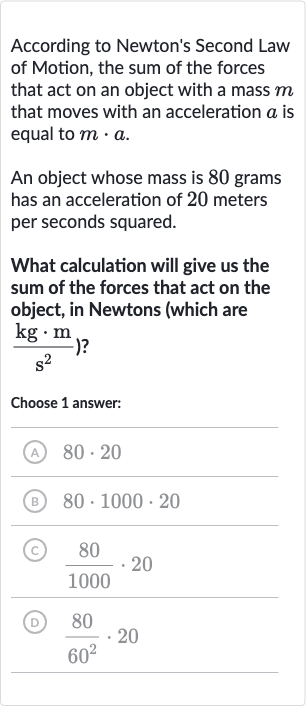AI tutor
Welcome to Bytelearn!
Let’s check out your problem:

According to Newton's Second Law of Motion, the sum of the forces that act on an object with a mass that moves with an acceleration is equal to . An object whose mass is grams has an acceleration of meters per seconds squared. What calculation will give us the sum of the forces that act on the object, in Newtons (which are )?Choose answer:(A) (B) (C) (D)
Full solution
Q. According to Newton's Second Law of Motion, the sum of the forces that act on an object with a mass that moves with an acceleration is equal to . An object whose mass is grams has an acceleration of meters per seconds squared. What calculation will give us the sum of the forces that act on the object, in Newtons (which are )?Choose answer:(A) (B) (C) (D)
- Newton's Second Law: Newton's Second Law of Motion states that the force acting on an object is equal to the mass of the object multiplied by its acceleration. The formula is , where is the force in Newtons, is the mass in kilograms, and is the acceleration in meters per second squared.
- Convert Mass to Kilograms: The mass of the object is given in grams and needs to be converted to kilograms because the unit for force (Newton) is expressed in kilograms. There are grams in a kilogram, so we divide the mass in grams by to convert it to kilograms. grams kilograms
- Calculate Force: Now we multiply the mass in kilograms by the acceleration to find the force.Force
- Perform Multiplication: Perform the multiplication to calculate the force. Newtons
- Correct Calculation: The correct calculation to find the sum of the forces acting on the object is therefore , which corresponds to choice (C).
